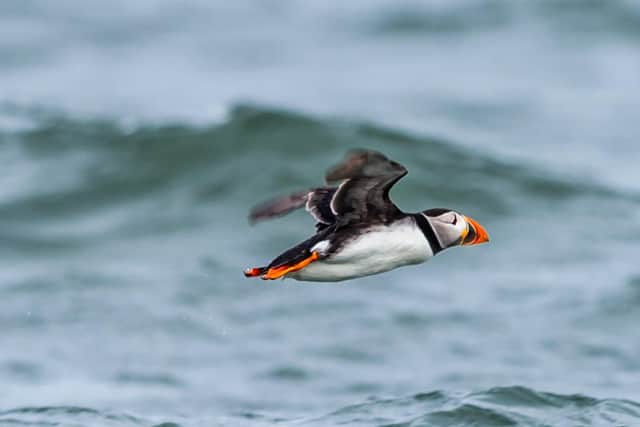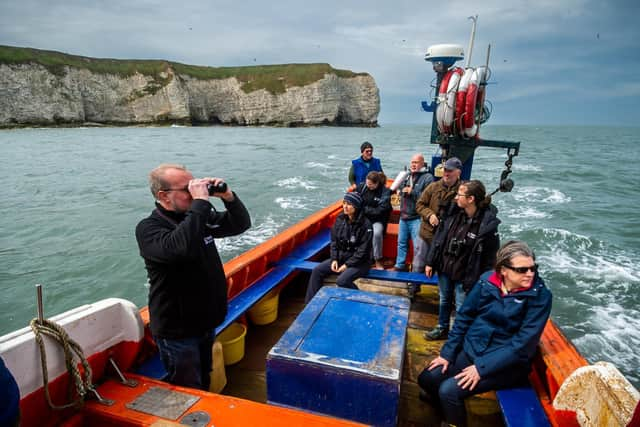Yorkshire Puffin Festival: How seabird supports tourism in Flamborough and beyond
Excuse me, have you seen a puffin? The question is asked by a blonde-haired girl of about seven with an unmistakable American accent.
She has come from Santa Monica to stay with grandma and is with her family to try to spot the iconic seabird at the Yorkshire Wildlife Trust’s (YWT) special nature reserve at Flamborough Cliffs.
Advertisement
Hide AdAdvertisement
Hide AdAt the North Landing beach area razorbills, guillemots and kittiwakes are perched precariously in their hundreds on the sheer cliffs, their version of high-rise flats, stretching maybe 150ft from the grassy tops to the North Sea below.


But we are both looking for a bird which has captured the imagination for generations, a charismatic black and white ‘sea parrot’, a sort of Hercule Poirot of the natural world with a gorgeous chunky beak of blue, red and yellow stripes, webbed feet and bright orange legs.
It stands around 30cms tall, is also sometimes referred to as the clown of the sea because of its spectacular beak, and now is the best time to spot one, after having spent its autumn and winter out at sea.
It’s spring, breeding time and they are back at Flamborough and the Yorkshire coastline until around July and, if all goes well, many pairs will produce a single chick, a puffling, in the next few weeks, leading to an intense period of feeding, rearing and protecting. Their nests are often in burrows but also in the nooks and crannies, which can go a long way into the cliffs.


Advertisement
Hide AdAdvertisement
Hide AdLike too much of our flora and fauna, the puffin globally is in decline, mainly down to climate change and the increasing vulnerability of its favourite food, the sandeel, an eel-shaped fish, which makes up 90 per cent of its diet. It can adapt and survive on pipefish and other morsels in the marine larder, but that’s like having to eat sprouts at Christmas with trifle on the horizon.
Yet in Yorkshire, the population has remained at a stable 4,000, according to the last count in 2018, when the first celebration of its residency came in the shape of the Yorkshire Puffin Festival.
It was a fly-away success and repeated the next year before the Covid plague put a stop to the fun. An online festival went ahead last year but now the real thing is back – and it’s all happening this weekend.
On Saturday and Sunday, with the help of backing from Yorkshire Coast BID, which promotes and helps tourism businesses and charities, the festival will take place at the Flamborough reserve.
Advertisement
Hide AdAdvertisement
Hide AdWriter and naturalist Stephen Rutt will give it an exclusive online launch but the main thrust of the festival is at the North Landing, where there will be family-based activities, including a seashore safari, guided walks with friendly experts, craft activities, storytelling, a puffin challenge, face painting and lots more besides.
Puffins can be easily spotted from the top of the cliffs, even better if you have binoculars, but perhaps the best place to see them and their other winged friends, with the rugged grandeur of the sheer chalk coastline as a spectacular backdrop, is from the sea itself.
Mike Emmerson and his family members have been making their living from the cove at the North Landing for years in their traditional Yorkshire cobles, the Prosperity and the Summer Rose.
When they are not used for landing crabs, the cobles double as the perfect ‘platform’ for those wanting to get up close with the marine life and can each carry around 28 people, having been launched from sloping beach to briny by a small tractor.
Advertisement
Hide AdAdvertisement
Hide AdToday the guests, on board with TV cameras, long lenses, pens, paper and recording machines, get a taste of puffin life to promote the upcoming festival.
Occasionally, in the pallid sun and the winds, the coble does a wobble on a sudden swell, and all aboard are testing their powers of balance as five or so grey seals bob up to have a nosey and then disappear under the waves, seemingly having fun with the photographers, who frustratedly scan the surface for a top shot.
At the tiller, Mike guides the Summer Rose along past Breil Nook, Selwicks Bay and up to Flamborough Head and its distinctive lighthouse, also taking in the impressive standalone queen stack (the accompanying king stack disappeared early last century) and smugglers caves. Whirling around us are gannets, cormorants, kittiwakes and herring gulls, while large groups of guillemot and razorbill take off from the sea as we approach.
A black-browed albatross, which has strayed from its normal environs in the Atlantic, has been patrolling this coastline over the past few weeks, having caused a stir among birders when it first appeared last summer, but there is no sign of it today.
Advertisement
Hide AdAdvertisement
Hide AdIn truth, the puffins are not out in great numbers, some swimming on the surface and taking flight, and others on sentry duty on the cliffs, sometimes difficult to identify as they tuck in away from the wind and turn those give-away beaks into their plumage.
But there’s a whole other side to the Flamborough puffins. While they battle daily for survival on the seas, they also support a growing tourist industry and help YWT gauge the health of the waters.
It’s a precarious balance, though, which could tip the wrong way at any time, and the puffins need as much protection as possible. On board with us is Bex Lynam, the trust’s North Sea marine advocacy officer, who explains the changing environment means the sandeel larvae might not develop into fish at the time the puffins most need it.
Over-fishing is also a concern and it’s a big help there has been new protection for sandeel and other aquatic wildlife at the Dogger Bank Special Area of Conservation farther out at sea.
Advertisement
Hide AdAdvertisement
Hide AdThe trust’s regional manager and puffin festival leader, David Craven, is also mindful this bird is important for tourism and ecology. It has been estimated it helps to generate £12m for development work in the East Riding and that might double at least in the coming years. In the Norfolk area the number is something like £44m, and that in the future would be a target for Yorkshire to aim for.
Tourism income helps the YWT employ around 160 people to not only run many reserves and projects, but to give puffins a helping hand. It’s win-win for the birds and their protectors.
Back on dry land, the little girl from California has found her way from the beach along the paths to the tops, marked along the way with picture boards of what’s in store for the patient cliff-watchers.
She proudly presents a trophy she’s discovered in the grass, an almost whole guillemot egg, with just a hole from which an opportunist predator has probably extracted the yoke for lunch.
Advertisement
Hide AdAdvertisement
Hide AdDown below, she has also finally spotted a puffin, guarding its nest site. For the rest of her days she is going to have treasured memories of staying with grandma and seeing the puffin at Flamborough Cliffs Nature Reserve.
And that’s absolute gold dust for the Yorkshire Wildlife Trust. The pulling power of the puffin.
